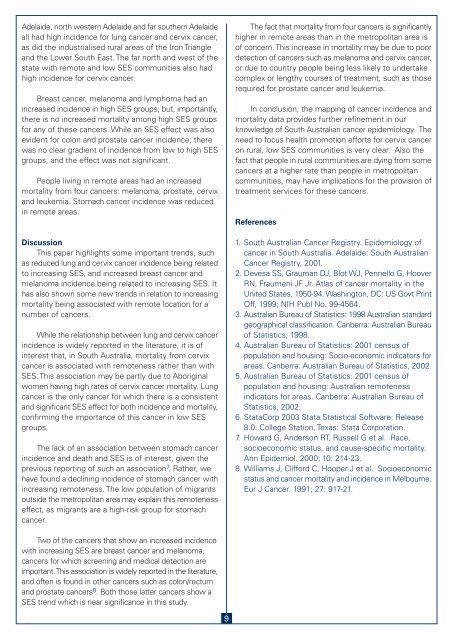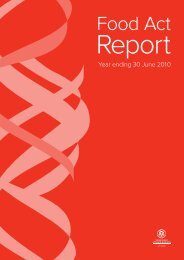Public Health Bulletin Edition 1, 2004 - SA Health - SA.Gov.au
Public Health Bulletin Edition 1, 2004 - SA Health - SA.Gov.au
Public Health Bulletin Edition 1, 2004 - SA Health - SA.Gov.au
Create successful ePaper yourself
Turn your PDF publications into a flip-book with our unique Google optimized e-Paper software.
Adelaide, north western Adelaide and far southern Adelaide<br />
all had high incidence for lung cancer and cervix cancer,<br />
as did the industrialised rural areas of the Iron Triangle<br />
and the Lower South East. The far north and west of the<br />
state with remote and low SES communities also had<br />
high incidence for cervix cancer.<br />
Breast cancer, melanoma and lymphoma had an<br />
increased incidence in high SES groups; but, importantly,<br />
there is no increased mortality among high SES groups<br />
for any of these cancers. While an SES effect was also<br />
evident for colon and prostate cancer incidence, there<br />
was no clear gradient of incidence from low to high SES<br />
groups, and the effect was not significant.<br />
People living in remote areas had an increased<br />
mortality from four cancers: melanoma, prostate, cervix<br />
and leukemia. Stomach cancer incidence was reduced<br />
in remote areas.<br />
Discussion<br />
This paper highlights some important trends, such<br />
as reduced lung and cervix cancer incidence being related<br />
to increasing SES, and increased breast cancer and<br />
melanoma incidence being related to increasing SES. It<br />
has also shown some new trends in relation to increasing<br />
mortality being associated with remote location for a<br />
number of cancers.<br />
While the relationship between lung and cervix cancer<br />
incidence is widely reported in the literature, it is of<br />
interest that, in South Australia, mortality from cervix<br />
cancer is associated with remoteness rather than with<br />
SES. This association may be partly due to Aboriginal<br />
women having high rates of cervix cancer mortality. Lung<br />
cancer is the only cancer for which there is a consistent<br />
and significant SES effect for both incidence and mortality,<br />
confirming the importance of this cancer in low SES<br />
groups.<br />
The lack of an association between stomach cancer<br />
incidence and death and SES is of interest, given the<br />
previous reporting of such an association 7 . Rather, we<br />
have found a declining incidence of stomach cancer with<br />
increasing remoteness. The low population of migrants<br />
outside the metropolitan area may explain this remoteness<br />
effect, as migrants are a high-risk group for stomach<br />
cancer.<br />
The fact that mortality from four cancers is significantly<br />
higher in remote areas than in the metropolitan area is<br />
of concern. This increase in mortality may be due to poor<br />
detection of cancers such as melanoma and cervix cancer,<br />
or due to country people being less likely to undertake<br />
complex or lengthy courses of treatment, such as those<br />
required for prostate cancer and leukemia.<br />
In conclusion, the mapping of cancer incidence and<br />
mortality data provides further refinement in our<br />
knowledge of South Australian cancer epidemiology. The<br />
need to focus health promotion efforts for cervix cancer<br />
on rural, low SES communities is very clear. Also the<br />
fact that people in rural communities are dying from some<br />
cancers at a higher rate than people in metropolitan<br />
communities, may have implications for the provision of<br />
treatment services for these cancers.<br />
References<br />
1. South Australian Cancer Registry. Epidemiology of<br />
cancer in South Australia. Adelaide: South Australian<br />
Cancer Registry, 2001.<br />
2. Devesa SS, Gr<strong>au</strong>man DJ, Blot WJ, Pennello G, Hoover<br />
RN, Fr<strong>au</strong>meni JF Jr. Atlas of cancer mortality in the<br />
United States, 1950-94. Washington, DC: US <strong>Gov</strong>t Print<br />
Off, 1999; NIH Publ No. 99-4564.<br />
3. Australian Bure<strong>au</strong> of Statistics: 1998 Australian standard<br />
geographical classification. Canberra: Australian Bure<strong>au</strong><br />
of Statistics, 1998.<br />
4. Australian Bure<strong>au</strong> of Statistics: 2001 census of<br />
population and housing: Socio-economic indicators for<br />
areas. Canberra: Australian Bure<strong>au</strong> of Statistics, 2002.<br />
5. Australian Bure<strong>au</strong> of Statistics: 2001 census of<br />
population and housing: Australian remoteness<br />
indicators for areas. Canberra: Australian Bure<strong>au</strong> of<br />
Statistics, 2002.<br />
6. StataCorp 2003 Stata Statistical Software: Release<br />
8.0. College Station, Texas: Stata Corporation.<br />
7. Howard G, Anderson RT, Russell G et al. Race,<br />
socioeconomic status, and c<strong>au</strong>se-specific mortality.<br />
Ann Epidemiol. 2000; 10: 214-23.<br />
8. Williams J, Clifford C, Hooper J et al. Socioeconomic<br />
status and cancer mortality and incidence in Melbourne.<br />
Eur J Cancer. 1991; 27: 917-21.<br />
Two of the cancers that show an increased incidence<br />
with increasing SES are breast cancer and melanoma,<br />
cancers for which screening and medical detection are<br />
important. This association is widely reported in the literature,<br />
and often is found in other cancers such as colon/rectum<br />
and prostate cancers 8 . Both those latter cancers show a<br />
SES trend which is near significance in this study.<br />
9

















